Timing at 28 degrees?
Timing at 28 degrees?
Hi folks,
I've got a few issues with my 65 Monza (110 hp PG)
I installed an automatic belt tensioner from Corvair underground, destroying my stock tensioner bracket in the process, and I noticed that at idle, the tensioner hops around like crazy, to the point it has tossed the belt once (new from Clark's) and knocks.
During my search to find a cause,I noticed that my engine had a steel pulley on the crank, not a harmonic balancer, and my timing had to be set around 28 degrees to run nice, minimum of 20 degrees to run at all. Any research I've done shows the stock timing is 14.
Thinking that the proper balancer may have different timing marks, and wanting the proper balancer on there anyway, I ordered up new balancer and crank seal from clarks.
Installed new parts, no change. The car runs pretty good, decent power, just doesn't idle very smooth in gear. I have the idle set to about 1100-1200 in neutral to get a smoothish 800-900 in gear. Any lower and the car won't sustain idle, and stalls.
Does this sound to anybody like a cam timing issue? Something else? I haven't touched the engine, so don't know what's inside, and it does seem to run pretty decent, although this is my first vair, so don't have anything to compare it to.
Any help would be really appreciated.
Thanks!
I've got a few issues with my 65 Monza (110 hp PG)
I installed an automatic belt tensioner from Corvair underground, destroying my stock tensioner bracket in the process, and I noticed that at idle, the tensioner hops around like crazy, to the point it has tossed the belt once (new from Clark's) and knocks.
During my search to find a cause,I noticed that my engine had a steel pulley on the crank, not a harmonic balancer, and my timing had to be set around 28 degrees to run nice, minimum of 20 degrees to run at all. Any research I've done shows the stock timing is 14.
Thinking that the proper balancer may have different timing marks, and wanting the proper balancer on there anyway, I ordered up new balancer and crank seal from clarks.
Installed new parts, no change. The car runs pretty good, decent power, just doesn't idle very smooth in gear. I have the idle set to about 1100-1200 in neutral to get a smoothish 800-900 in gear. Any lower and the car won't sustain idle, and stalls.
Does this sound to anybody like a cam timing issue? Something else? I haven't touched the engine, so don't know what's inside, and it does seem to run pretty decent, although this is my first vair, so don't have anything to compare it to.
Any help would be really appreciated.
Thanks!
65 Monza 110
- bbodie52
- Corvair of the Month

- Posts: 12141
- Joined: Mon Aug 06, 2012 12:33 pm
- Location: Lake Chatuge Hayesville, NC
- Contact:
Re: Timing at 28 degrees?
I wrote these comments back in 2014. I believe the woodruff key notch that indexes the pulley or harmonic balancer center hub with the crankshaft aligns with the timing mark on the outer rim of any Corvair pulley. A slipping outer ring on a harmonic balancer can knock this indexing out of proper alignment, but the alignment of a steel or solid cast pulley cannot change.
 The shop manual indicates that the correct ignition timing setting for the 110 hp engine is 12°-16° BTDC.
The shop manual indicates that the correct ignition timing setting for the 110 hp engine is 12°-16° BTDC.
Your comments about possible timing mark inaccuracies caught my attention. Your 110 hp 1966 Monza has a harmonic balancer. Harmonic balancers are three-piece assemblies with a cast inner mount attached to the crankshaft, an outer steel ring, and the two are a press fit with a rubber insert that holds the two metal components together. As the harmonic balancer ages the press fit between the two metal components can begin to loosen, and the outer ring can slip. This could mean that the outer ring would no longer be in proper alignment with the center part, which is held in place on the crankshaft with a Woodruff key. With a solid crankshaft pulley the Woodruff key ensures proper positioning of the timing mark on the outer edge of the pulley. But with a faulty harmonic balancer the outer mark can slip, which can mean your timing mark may no longer be accurate.
The Corvair shop manual indicates that there should be a registration mark on the face of the harmonic balancer that indicates a proper relationship between the inner hub and outer ring. If the mark is there but the two parts are not in alignment, the harmonic balancer has slipped and is failing and must be replaced.
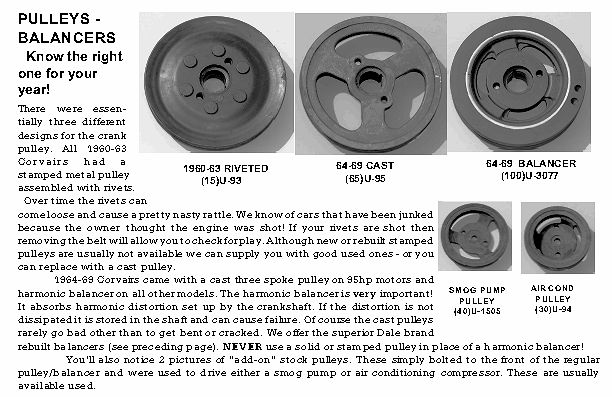
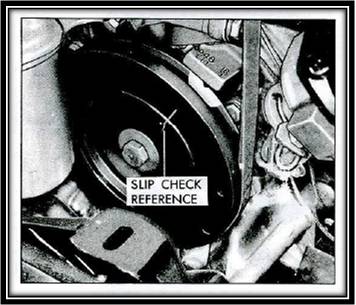
You can read more about harmonic balancer slippage at the following Corvair Center link...
 http://corvaircenter.com/phorum/read.ph ... 740,494964
http://corvaircenter.com/phorum/read.ph ... 740,494964
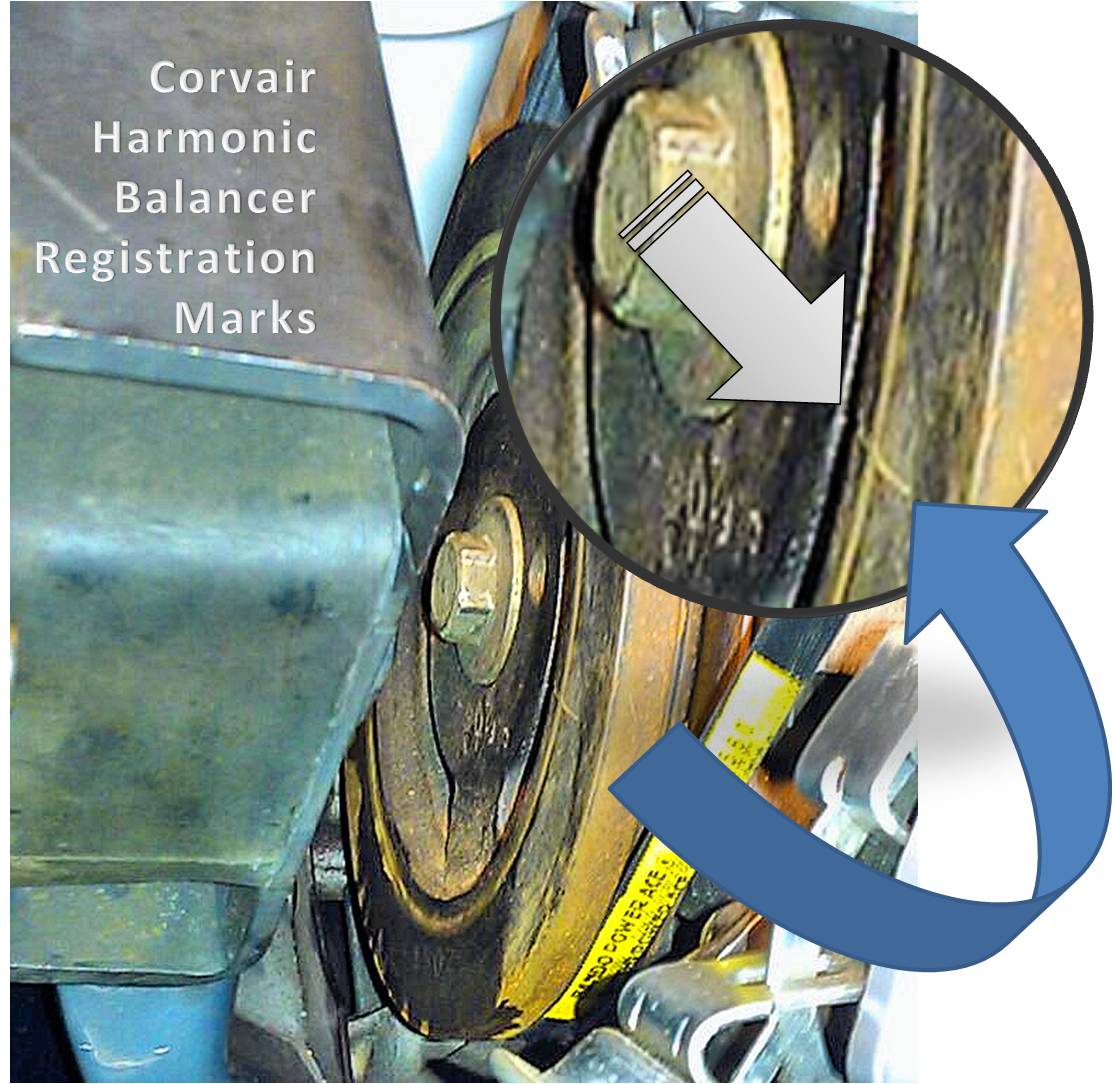
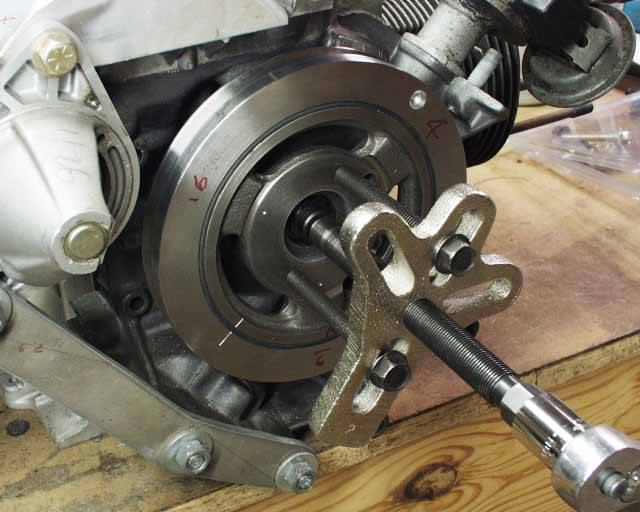
If your harmonic balancer is slipping and proves to be faulty, it must be replaced because it would eventually fail completely and possibly damage your engine in the process. Do not be tempted to replace it with a cheaper standard pulley. It is a critical component that helps prevent damage and cracks from forming on the 164 CI engine crankshaft. Also, a used harmonic balancer replacement may not be a wise choice, unless it has been remanufactured properly. Age causes deterioration in the rubber component of the harmonic balancer, and buying a used item — even if the registration marks are OK — means that you have no way of knowing how much life is left in the used part.
 http://www.corvair.com/user-cgi/catalog ... ge=OTTO-23
http://www.corvair.com/user-cgi/catalog ... ge=OTTO-23
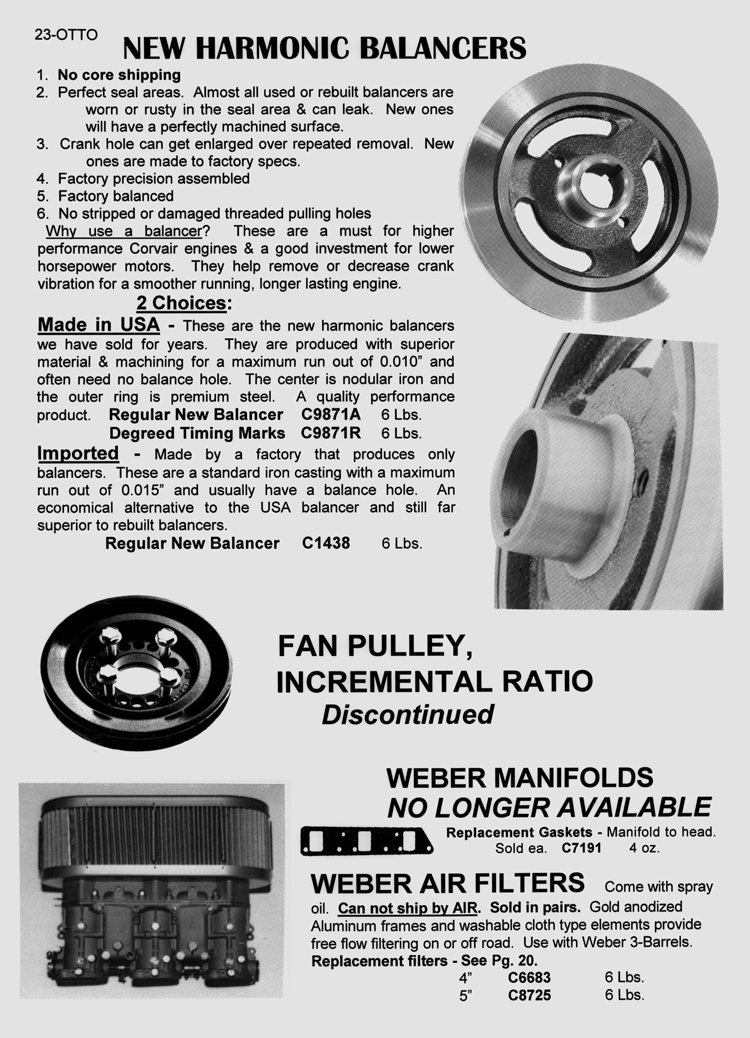
If you determine that you must replace the harmonic balancer, the following video will help to guide you through the procedure...
91blaze wrote:...Checked the timing, it was just a little too advanced but it starts and runs fine now with a little adjusting. The timing shows almost 20 but it doesn't act that high, I'm assuming something is off on the timing marks...
Your comments about possible timing mark inaccuracies caught my attention. Your 110 hp 1966 Monza has a harmonic balancer. Harmonic balancers are three-piece assemblies with a cast inner mount attached to the crankshaft, an outer steel ring, and the two are a press fit with a rubber insert that holds the two metal components together. As the harmonic balancer ages the press fit between the two metal components can begin to loosen, and the outer ring can slip. This could mean that the outer ring would no longer be in proper alignment with the center part, which is held in place on the crankshaft with a Woodruff key. With a solid crankshaft pulley the Woodruff key ensures proper positioning of the timing mark on the outer edge of the pulley. But with a faulty harmonic balancer the outer mark can slip, which can mean your timing mark may no longer be accurate.
The Corvair shop manual indicates that there should be a registration mark on the face of the harmonic balancer that indicates a proper relationship between the inner hub and outer ring. If the mark is there but the two parts are not in alignment, the harmonic balancer has slipped and is failing and must be replaced.
You can read more about harmonic balancer slippage at the following Corvair Center link...

If your harmonic balancer is slipping and proves to be faulty, it must be replaced because it would eventually fail completely and possibly damage your engine in the process. Do not be tempted to replace it with a cheaper standard pulley. It is a critical component that helps prevent damage and cracks from forming on the 164 CI engine crankshaft. Also, a used harmonic balancer replacement may not be a wise choice, unless it has been remanufactured properly. Age causes deterioration in the rubber component of the harmonic balancer, and buying a used item — even if the registration marks are OK — means that you have no way of knowing how much life is left in the used part.

If you determine that you must replace the harmonic balancer, the following video will help to guide you through the procedure...
Brad Bodie
Lake Chatuge, North Carolina
 1966 Corvair Corsa Convertible
1966 Corvair Corsa Convertible
Lake Chatuge, North Carolina
 1966 Corvair Corsa Convertible
1966 Corvair Corsa ConvertibleRe: Timing at 28 degrees?
Sorry, PG cars are more sensitive to idle issues. Ignition problems & vacuum leaks plus other things add up in a hurry.
Jeremy (cad-kid)
Kronenwetter, WI (Central Wisconsin)
SOLD 9-2016 65 Monza 4spd/140
My 65 Monza thread
 My YouTube page
My YouTube page
Kronenwetter, WI (Central Wisconsin)
SOLD 9-2016 65 Monza 4spd/140
My 65 Monza thread
Re: Timing at 28 degrees?
The timing may be right where it's supposed to be. Don't forget the mechanical advance kicks in pretty early. If you can't get the idle speed down to 600 rpm, you're always going to see more advanced timing than the specs. And did you disconnect the vacuum advance and seal the line when you were checking the timing?
You need to find the reason it won't idle slower. Check every vacuum connection, especially the balance tube and the small line that goes to the powerglide. Then sync the carbs. If you still can't get down more, check for worn throttle shafts in the carbs.
This is not likely a cam issue, and the harmonic balancer, while needed on your engine, is not the culprit either.
Jim
You need to find the reason it won't idle slower. Check every vacuum connection, especially the balance tube and the small line that goes to the powerglide. Then sync the carbs. If you still can't get down more, check for worn throttle shafts in the carbs.
This is not likely a cam issue, and the harmonic balancer, while needed on your engine, is not the culprit either.
Jim
Jim Thomas
Bethel, VT
63 Monza Coupe
Bethel, VT
63 Monza Coupe
-
64powerglide
- Posts: 1604
- Joined: Tue Mar 25, 2014 9:18 pm
- Location: Kalamazoo Mi..
Re: Timing at 28 degrees?
What for sure engine do you have? Sounds like a 95 hp, did you post the engine number yet?? I just got my 64 110 started today, had the trans & diffy checked out over the winter & all the trans needed was a low band adjustment. Got it warmed up good today & had to back the idle down & when I put it in gear it was real smooth, no hard clunk and I now have a lower idle speed when going to drive or reverse.
64Powerglide, Jeff Phillips
Kalamazoo, Mi..
Kalamazoo, Mi..
Re: Timing at 28 degrees?
So just a quick update,
The tensioner was really driving me crazy, so I disassembled it today and placed a piece of rubber tube about 1" long in the middle of the spring in hopes of dampening the pulsations and when I tightened the pivot bolts, the tensioner became pretty rigid. (Not over tight, I had to loosen the bolts slightly in order for it to move right from new)
I regret installing this tensioner, huge waste of money IMO, but broke the old bracket removing the pulley so no going back. When I can afford, I'll replace with an original style tensioner.
It runs smoother now, I increased the idle speed very slightly and it no longer stalls.
Still have no idea why I have to run the timing so far advanced, but it's runs strong so I'll leave it alone.
Thanks for the input those that took the time to reply
The tensioner was really driving me crazy, so I disassembled it today and placed a piece of rubber tube about 1" long in the middle of the spring in hopes of dampening the pulsations and when I tightened the pivot bolts, the tensioner became pretty rigid. (Not over tight, I had to loosen the bolts slightly in order for it to move right from new)
I regret installing this tensioner, huge waste of money IMO, but broke the old bracket removing the pulley so no going back. When I can afford, I'll replace with an original style tensioner.
It runs smoother now, I increased the idle speed very slightly and it no longer stalls.
Still have no idea why I have to run the timing so far advanced, but it's runs strong so I'll leave it alone.
Thanks for the input those that took the time to reply
65 Monza 110
Re: Timing at 28 degrees?
Something doesn't sound right with your tensioner install. I have had one of those units on my car for years and have never thrown a belt. And it doesn't hop around or do anything weird while idling.
Nate Wolfe
65 Corsa 180
61 Lakewood 140
65 Corsa 180
61 Lakewood 140
Re: Timing at 28 degrees?
I don't think there's anything wrong with the install or the tensioner itself per se, but there must be a crank pulsation or pulley issue causing an uneven load on the tensioner. It's not misfiring, but maybe there's been a lumpier cam installed, maybe an issue with the alternator. All I know is that with a fixed tensioner, it seems pretty smooth.
Even with some modern engines, the auto tensioner has to be dampened, or they bounce around like crazy and can knock if the dampener goes bad. I'll just run it like this for now, and troubleshoot when I have the time.
Even with some modern engines, the auto tensioner has to be dampened, or they bounce around like crazy and can knock if the dampener goes bad. I'll just run it like this for now, and troubleshoot when I have the time.
65 Monza 110
-
aquavit750
- Posts: 15
- Joined: Sun Oct 07, 2018 8:10 am
- Location: Sparks, NV
Re: Timing at 28 degrees?
I’ve read and been told that the original spcs set forth in any of the manuals from the 60’s are not valid anymore. Due to all the “extras” in modern fuel it burns much slower than Hint o’ lead 60’s fuel did. So timing must be more advanced than the manual. I did this with my ‘66 imapala eemed to do better. Haven’t got to that point yet on my Corvair rebuild. Im not positive of the setting, any feedback would be welcome.
Re: Timing at 28 degrees?
So far some good advice. Depending on the year - mechanical advance starts between 800 - 1,200 RPM and I ALWAYS verify static timing at 600-700 RPM.
Long ago when I first bought a used Corvair the forums were full of "fan belt toss issues". Lots a "creative" fixes. One day an experienced Corvair person advised me that a properly set up belt is very reliable. No need for an afermarket tensioner. I followed his advice and have NEVER had a fan belt come loose on my two Corvairs.
Issues to check: Rust or pitting on the pulleys, Install ALL the LM fan belt guides, verify the fan bearing is installed at proper height (a fellow did a test and found anything over +/- 1/8" from nominal causes the belts to flip/jump off - spec. in shop manual). And of course tension. The now agreed upon finger test - at the generator/alternator fan a finger should be able to move the fan in one direction with minor resistance, but it will be very difficult to move the fan in the opposite rotation.
Finally - after decades many Corvairs have a mis-match of carbs, distributor, and other engine parts. Always best to determine what parts are on the engine.
Long ago when I first bought a used Corvair the forums were full of "fan belt toss issues". Lots a "creative" fixes. One day an experienced Corvair person advised me that a properly set up belt is very reliable. No need for an afermarket tensioner. I followed his advice and have NEVER had a fan belt come loose on my two Corvairs.
Issues to check: Rust or pitting on the pulleys, Install ALL the LM fan belt guides, verify the fan bearing is installed at proper height (a fellow did a test and found anything over +/- 1/8" from nominal causes the belts to flip/jump off - spec. in shop manual). And of course tension. The now agreed upon finger test - at the generator/alternator fan a finger should be able to move the fan in one direction with minor resistance, but it will be very difficult to move the fan in the opposite rotation.
Finally - after decades many Corvairs have a mis-match of carbs, distributor, and other engine parts. Always best to determine what parts are on the engine.
Re: Timing at 28 degrees?
I should have added that the auto parts stores (and belt manufacturers) list the WRONG fan belt for the Corvair - it's too wide.
The Gates 3V560 is correct. The Clark's belt is also the correct size. Note that often a new belt will stretch and should be checked every 100 miles until it holds the proper tension. Usually two or three adjustments are all that is needed.
The Gates 3V560 is correct. The Clark's belt is also the correct size. Note that often a new belt will stretch and should be checked every 100 miles until it holds the proper tension. Usually two or three adjustments are all that is needed.